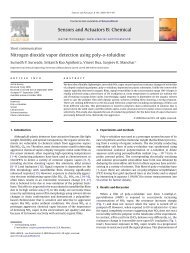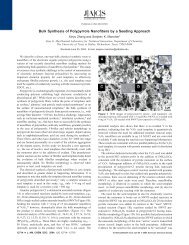Nanofibers of polyaniline synthesized by ... - Sanjeev Manohar
Nanofibers of polyaniline synthesized by ... - Sanjeev Manohar
Nanofibers of polyaniline synthesized by ... - Sanjeev Manohar
Create successful ePaper yourself
Turn your PDF publications into a flip-book with our unique Google optimized e-Paper software.
26 X. Zhang et al. / Synthetic Metals 145 (2004) 23–29<br />
80 ◦ C for ∼12 h. A solution in NMP was made <strong>by</strong> adding<br />
the <strong>polyaniline</strong> powder, in ∼10 mg quantities, to 10 ml NMP<br />
and stirring for 2 h to ensure complete dissolution. Forty<br />
milliliter <strong>of</strong> acetonitrile was added and stirred for ∼1h to<br />
precipitate the <strong>polyaniline</strong> base from solution (acetonitrile<br />
is a non-solvent for <strong>polyaniline</strong> base). The resulting bronze<br />
precipitate was suction filtered and redoped <strong>by</strong> suspending<br />
it in 1 l <strong>of</strong> a stirred solution <strong>of</strong> aq. 1.0 M AMPSA for ∼12 h.<br />
Suction filtration and drying in the usual manner (described<br />
above) resulted in a bright green powder <strong>of</strong> non-fibrillar<br />
<strong>polyaniline</strong>·AMPSA (determined <strong>by</strong> SEM).<br />
3. Results and discussion<br />
A repeat <strong>of</strong> published work on the interfacial oxidative<br />
polymerization <strong>of</strong> aniline using a solution <strong>of</strong> aniline in<br />
toluene as the top organic phase and acidic ammonium<br />
peroxydisulfate as the bottom aqueous phase resulted in<br />
<strong>polyaniline</strong>·CSA nan<strong>of</strong>ibers <strong>of</strong> average fiber diameter <strong>of</strong><br />
∼48 nm (smallest ∼30 nm; largest ∼90 nm) consistent with<br />
the literature value <strong>of</strong> ∼30–60 nm for average diameter<br />
[1]. Also, as described previously, when the reaction is<br />
carried out in the aqueous phase alone, i.e., a conventional<br />
one-phase synthesis, the precipitate <strong>of</strong> <strong>polyaniline</strong>·CSA obtained<br />
had non-fibrillar morphology. While reasons for the<br />
formation <strong>of</strong> nan<strong>of</strong>ibers during interfacial polymerization<br />
are not clear, it appears that fibrillar growth is favored in systems<br />
in which: (a) the kinetics <strong>of</strong> monomer migration into<br />
the aqueous phase is significantly reduced, and (b) large soluble<br />
aggregates (monomer- or oligomer-based) are present<br />
at the interface. Compared to interfacial polymerization using<br />
aq. 1.0 M HCl, the onset <strong>of</strong> the reaction is significantly<br />
delayed when CSA is used. Just prior to the onset <strong>of</strong> the<br />
polymerization, one might anticipate the anilinium·CSA salt<br />
to accumulate at the interface and form larger aggregates as<br />
the interface becomes increasingly packed. We believe these<br />
aggregates could play an important role in orchestrating fibrillar<br />
polymer growth. We reasoned that any organic dopant<br />
possessing good interfacial packing properties should<br />
help promote fibrillar morphology <strong>by</strong> both “a” and “b”<br />
above.<br />
Indeed, when the reaction is carried out using aq.<br />
1.0 M AMPSA as the aqueous phase, <strong>polyaniline</strong>·AMPSA<br />
nan<strong>of</strong>ibers <strong>of</strong> average fiber diameter ∼23 nm (smallest<br />
14 nm; largest 40 nm) are obtained (Fig. 2, Table 1). The<br />
smaller average fiber diameter observed with AMPSA (versus<br />
CSA) is consistent with AMPSA’s more linear structure<br />
which might be expected to pack the interface more efficiently<br />
than CSA. There are two important points to note in<br />
these reactions: (a) the interface is not disturbed during the<br />
reaction (not stirred), and (b) the reaction is a precipitation<br />
polymerization, i.e., a precipitate forms almost immediately<br />
after the onset <strong>of</strong> polymerization. This precipitate, first observed<br />
as a thin greenish layer at the liquid–liquid interface,<br />
“grows” as more polymer is formed. Since this “early”<br />
precipitate is also expected to possess fibrillar morphology,<br />
surface active additives like surfactants, dopants, etc., could<br />
significantly affect fiber properties <strong>by</strong> influencing the kinetics<br />
<strong>of</strong> monomer migration across the interface <strong>by</strong> competing<br />
for the available and undisturbed interfacial area.<br />
Using commercial non-ionic and anionic surfactants<br />
yielded the following results. Single-tailed non-ionic surfactants<br />
increase the average fiber diameter, e.g., both<br />
Triton-X 100 and Vitamin E TPGS increased the fiber diameter<br />
<strong>of</strong> <strong>polyaniline</strong>·CSA from ∼50 to ∼80 nm (Table 1).<br />
Conventional single-tailed anionic surfactants like DBSA<br />
not appear to have any significant impact on fiber diameter.<br />
Twin-tailed surfactants, however, seem to reduce fiber diameter,<br />
e.g., aerosol-OT (AOT) reduced the fiber diameter<br />
<strong>of</strong> <strong>polyaniline</strong>·CSA from ∼50 to ∼30 nm.<br />
We then evaluated a largely unexplored class <strong>of</strong> surfactants<br />
based on the cis-1,2-dialkylethene sulfonate structure.<br />
We chose this family <strong>of</strong> twin-tailed surfactants since, to the<br />
best <strong>of</strong> our knowledge, this is the only class <strong>of</strong> surfactants<br />
that contain a central double bond that permanently separates<br />
the twin hydrophobic alkyl tails from the hydrophilic<br />
sulfonate head group (Table 1) [21]. When chemical oxidative<br />
interfacial polymerization is carried out with twin-tailed<br />
surfactants, the kinetics <strong>of</strong> initiation <strong>of</strong> the polymerization is<br />
Fig. 2. SEM images <strong>of</strong> <strong>polyaniline</strong>·AMPSA powder <strong>synthesized</strong> <strong>by</strong> chemical oxidative polymerization: (A) conventional single-phase synthesis, (B)<br />
interfacial synthesis.




